Dawn of War has been a franchise that’s experimented widely with the RTS formula, changing approach wildly with its second game. While this has resulted in interesting takes on the RTS genre, it has seen a community splinter due to very clear preference divide. Dawn of War III hopes to reunite those differing tastes, while still looking to introduce new twists on the genre.
The campaign of Dawn of War III involves conflict between the Space Marines from the Blood Ravens chapter, the Eldar of Biel Tan, and the Orks from the Evil Sunz clan, as they struggle to gain control over a legendary artefact, the Spear of Khaine, locked away on the ancient world of Acheron that only emerges from the Warp once every 5000 years. Both the Eldar and Orks fight to gain control of the mythical spear, while the Space Marines interject to prevent anyone from attaining it.
The story often references events from the first Dawn of War and its first expansions, and this is seen most immediately in the return of Macha, Taldeer, and Gorgutz as the protagonists and leaders of their respective factions that you play. The Eldar, led by Autarch Kyre, follow a prophecy that they believe will lead to and grant them the Spear of Khaine, empowering their craftworld to greater glory, though Macha fears that something dark lies within the prophecy. Gorgutz has heard about great wealth (or what passes for wealth for Orks) hidden on Acheron, and has weaselled his way into a position to gain control of a large Ork horde to invade and plunder Acheron when it arrives.
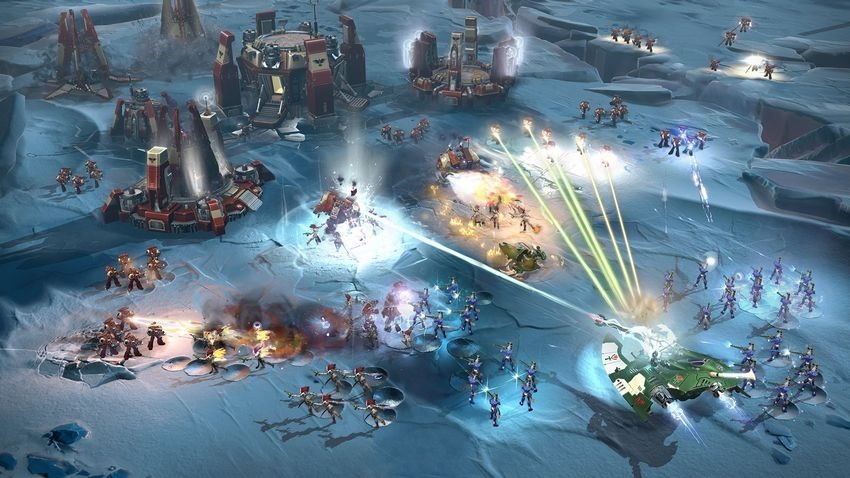
Gabriel Angelos returns, now the Chapter Master of the Blood Ravens since the events of Dawn of War II: Retribution. Initially brought in to assist an Inquisitor, Gabriel learns of Acheron and the artefact held within, and vows to prevent any from reaching an artefact he deems to powerful regardless of who wields it.
The Dawn of War franchise has suffered somewhat when it comes to strong campaign narratives since Dawn of War: Dark Crusade made the shift to a narratively light “meta-campaign”. While Dawn of War II improved matters, the story was still diluted due to simplistic and repetitive missions and the reuse of maps. Dawn of War II: Retribution’s approach to its campaign resulted in a story that was the end product of cuts, resulting in a narrative that was awkward and disappointing. That’s not to say the games weren’t fun, I had a wonderful time playing through all of these, but the stories themselves were always ultimately disappointing to someone who’s a fan of the setting.
Which means the fact that Dawn of War III finally returns to a linear structured campaign makes me very happy.
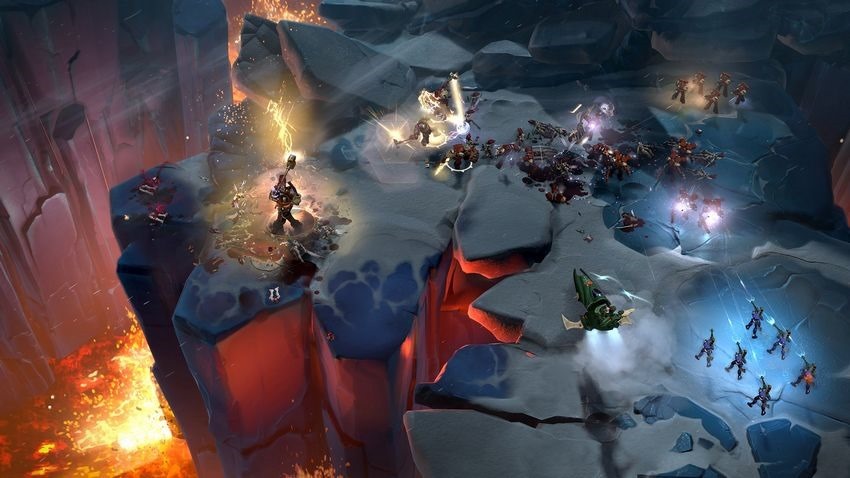
The story itself won’t blow anyone’s minds, and they still fall back on some over used tropes seen all too often in 40k game narratives, but having a properly fleshed out narrative that progresses comfortably is immensely refreshing and it’s still very enjoyable. It’s also allowed them to construct missions and maps that are detailed, several with small nods to a greater narrative and the larger universe in general.
The campaign alternates between the factions as the story progresses, and you’ll not play two missions as the same faction one after the other. While this means that you won’t have more than half a dozen missions as each faction, there’s a good amount of narrative momentum that does a good job of hiding that you’re not spending that much time with each race. I had a really fantastic time with the campaign, barring a particularly frustrating finale that soured my experience somewhat. Still, it’s definitely a favourite since the very first Dawn of War, especially considering the weaker previous entries. Focusing on a linear campaign has allowed Relic to craft levels that try different things that, while not groundbreaking, are still great fun.
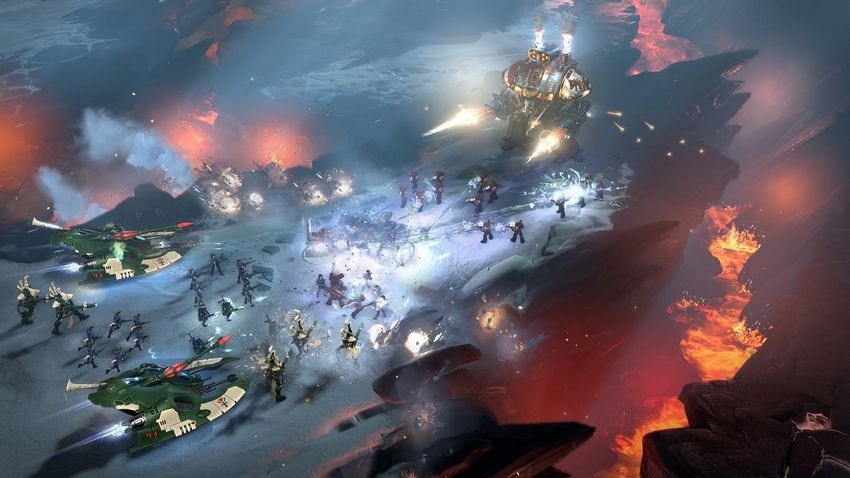
Visually, the game looks great. There’s an intentional shift towards a more simplistic art-style and a focus on unit visibility, but I honestly didn’t notice any particular drop in detail as I played, as at very least the units and buildings are as detailed as in previous games. Cutscene, barring the impressive introductory cinematic, rely on still images, something of a trait in Relic cinematics, though they work well for what they intend to do and are illustrated wonderfully. Voice acting is great on all levels, though the Orks, Gorgutz in particular, are more than ever cockney hooligans straight out the film Snatch. They’re still slightly goofier than I’m comfortable with, but I had several genuine laughs as a result of the cockney Ork dialogue.
Multiplayer is where Dawn of War thrives, so let’s have a talk about how that’s changed and evolved.
It’s accurate to say that Dawn of War III’s general feel is a middle point between the previous two entries, with some new mechanics tossed in. The second game created a schism in the community, as many players felt that what they enjoyed had been removed through a shift away from base building and large armies towards greater focus on map control and micromanagement of fewer but more capable units. Dawn of War III looks to merge what the developers felt was the most fun, interesting, and successful aspects of the previous games, hopefully reuniting the fanbase.
The most immediate result of this is that base building has returned, though it’s not nearly as complex as one may expect. Each faction has no more than five buildings it can construct, not counting listening posts, nor HQs, which can no longer be built. Like Dawn of War II, the only “research” that unlocks units, buildings, and upgrades are the Tier upgrades for Space Marines and Eldar, and a WAAAAAGH!!! Tower quantity requirement for Orks. Turrets, however, are not present despite the return of base building – the closest you can get are the listening posts each faction can build to protect resource points, and the WAAAAAGH!!! Tower for Orks. Otherwise, it’s up to your units to hold ground. While I was initially concerned about the simple base building, as I played games I quickly found it worked perfectly for what the game needed – there’s no need for anything more complex.
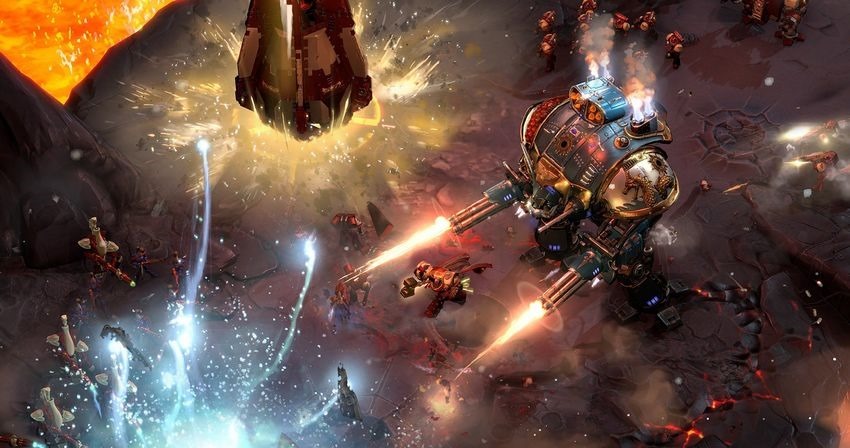
It’s clear that the game still wants to keep Dawn of War II’s focus on battlefield control and unit micromanagement rather than base management, and as capturing points around the map is still the core gameplay, though it’s now possible (and often advisable) to construct forward bases as one pushes forward.
And forward momentum is now an important aspect of multiplayer games. As with previous games, you need to move out into the map to control nodes to gather resources. However, rather than simply destroying your opponent’s base as in Dawn of War 1, or holding Victory Point nodes in Dawn of War 2, teams must push to and destroy a series of objectives, ultimately destroying the opposing team’s power core. MOBA influence is evident here, though the process is more direct. Each team has a single shield generator, up to three giant turrets, and a single power core, in that order. Initially, only the shield generator can be damaged, but destroying it makes the turrets vulnerable, and destroying them finally allows you to attack the opponent’s power core.
While this sounds may like large shift in terms of gameplay, it’s more accurate to say that it’s most similar to the area control gameplay of Dawn of War II but with more direction – simply holding points won’t win you the game anymore, you need to be more aggressive!

As with Dawn of War II, most units have abilities that you can activate – many of which need a second prompt to indicate where you want that ability to target. While at the start of a match it’s trivial to manage this, by the end of most of them things are often so chaotic that one is often forced to micro crucial key units while mobbing the rest forward into the meat grinder.
To help with this, the environment itself has been largely simplified. Cover and buildings are gone – in its stead are “heavy cover” areas, circular domes that when controlled provide a shield that protects the units inside from ranged firepower and abilities, though melee units can still enter and attack those within without issue. While I certainly enjoyed using cover in Dawn of War II, I found I didn’t miss it as I was playing Dawn of War III. The removal of a retreat button, however, is definitely something I sorely wish had remained.
There are only three races available, being the same you play in the campaign, though they are nicely diversified, and arguably more diverse and unique than they’ve been in previous games. Space Marines can build units and use drop pods to deliver them to the front line immediately. Eldar are fast, can teleport their structures, and can move units from one structure to another. Orks can use the debris from any destroyed buildings and vehicles to upgrade their units, and even build vehicles at a large discount – all very pleasingly thematic and fitting, considering the lore surrounding the facitons. The Orks’ WAAAAAGH!!! Tower even has explosions, a light show, and an Ork on a mic encouraging the other Orks when you activate the WAAAAAGH!!! Ability. It’s beautiful.
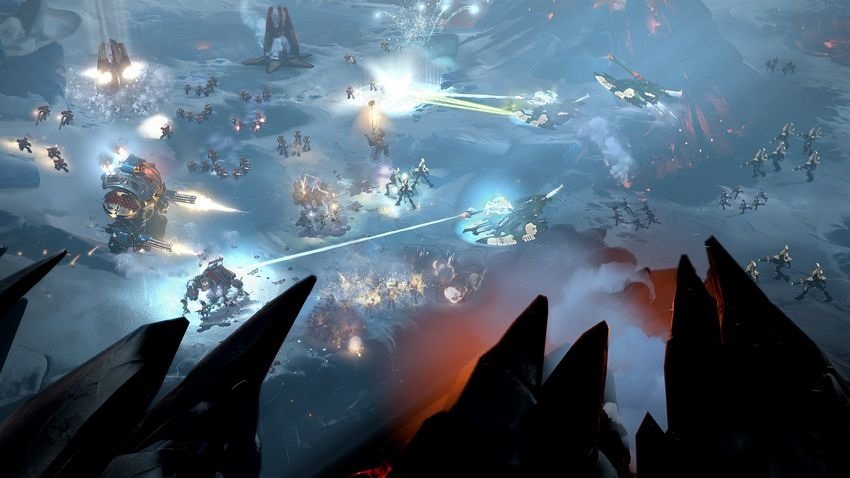
This variety is further diversified by a large degree of customization available to you as you prepare for games. While Dawn of War II had Heroes which you chose before each game, and these would have a large impact on your play style, Dawn of War III has done away with this and instead introduced Elite units and Doctrines.
Doctrines are boosts to specific units or structures, either providing a passive boon or an ability to that unit it would otherwise not have. There is a large selection to choose from (each faction has 29 doctrines), and they’re a nice way to slightly empower specific playstyles or units you enjoy.
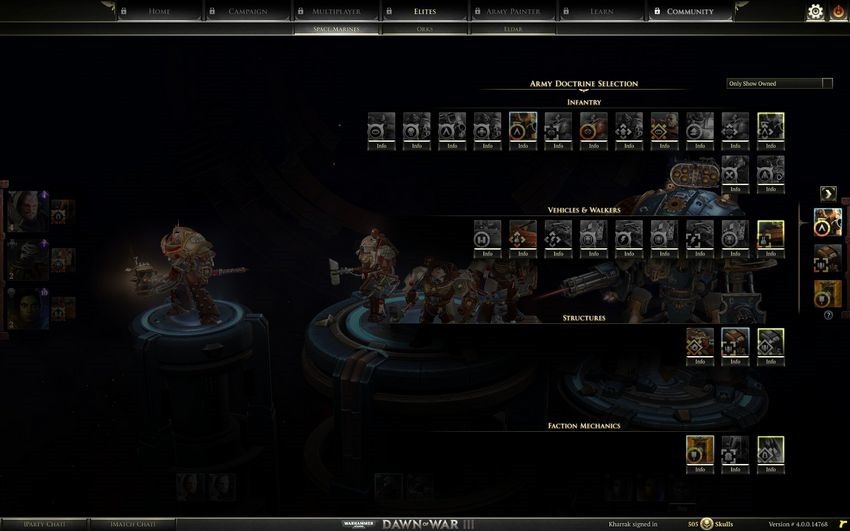
Elite units are definitely the most important mechanic you can customize. Before each game you choose three Elite units (each race has a selection of 9 elite units they can choose from), and those will be the only elite units you field for the game. These units aren’t bought with standard resources, but through a new third resource called Elite Points that build up slowly over time.
Once purchased and brought to the field they serve as formidable forces in the battlefield, though the slow accumulation of Elite points ensures that the more powerful elite units only appear in mid or late game. If they are killed, you won’t need to purchase them again, but you will need to wait several minutes before they can be brought back into the fight.
These units are definitely a power focus in your army, and their selection can be crucial. Selecting cheaper elite units ensures they’ll see play, but they aren’t nearly as devastating nor as survivable as some of the more terrifying and overwhelming elite units. Additionally, they also provide buffs to specific units wile on the field, so your choice will affect how you play, and when you choose to be offensive or defensive. A cheap elite unit that boosts a unit that’s good for defence, and an expensive elite unit that boosts a unit that’s good for offense, will obviously encourage a playstyle that’s early game defensive, and late game offensive.
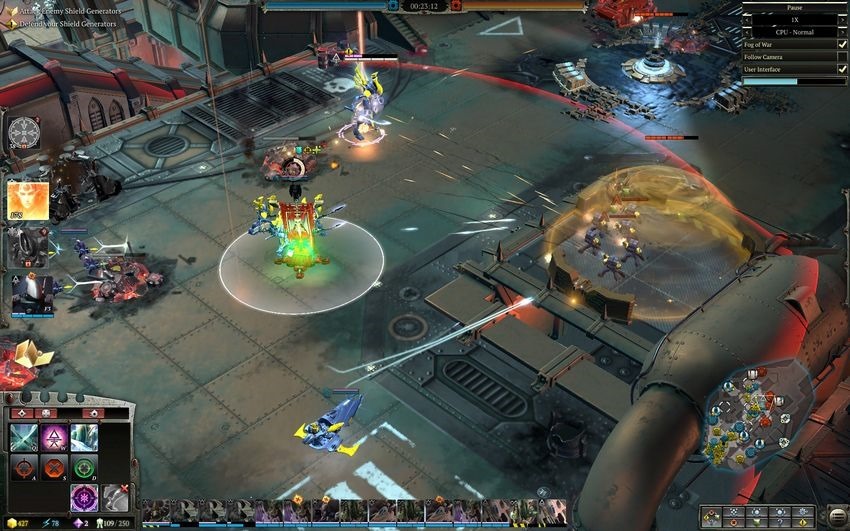
One way to look at them is to say that the cheaper elite units augment your force, allowing you to re-inforce a front line, or safe yourself from tricky situations. The expensive elite units, however, are heavy linebreakers that push through and into enemy lines. These heavies do have weaknesses though: many are either vulnerable to melee combat and slow, while others are massive glass cannons that break relatively easily.
In my experience, though, if these are well supported you may be hard pressed to push back the tide, especially if you’re underprepared. You’ll also need to counterattack quickly if you manage to destroy an opponent’s heavy elite unit, lest they get it back in time to harass you before you’ve gained that momentum.
Both Elite units and Doctrines aren’t fully available from the start. Barring an initial starting selection to get you going, the rest need to be unlocked through an in-game currency called Skulls. There are two main ways to generate skulls: Firstly, by playing through the campaign you’ll generate a large amount of resources. By the end of the 4th mission, I had enough to unlock four elites, and by the end of the campaign, I had enough Skulls to unlock most elite units, and unlock a few doctrines that really interested me.

The other way is to simply use your Elite units in both the campaign and multiplayer. As you use them, they’ll gain experience and level up, unlocking either skulls, new doctrines, skins, and colours for the army painter. While the ones you use in the campaign will get a notable bump in levels, levelling elites will definitely be a long term process as you continue to play games.
A word of caution, however: if you don’t have an internet connection, or if the Relic servers are down, you won’t gain any experience for your elite units while playing through the campaign.
I’m somewhat uncomfortable with the need to unlock these aspects, but in the games I’ve played so far I’ve not actually felt that I’ve suffered from not having unlocked certain doctrines and elites, as I’d already picked the three or four for each faction that I was most interested in. Thankfully, gaining Skulls from singleplayer means there’s at least a fun and relatively easier way to build them up rather than grinding online matches.
I’ve really enjoyed my experience with the multiplayer. The matches are wonderfully chaotic and destructive, and it’s a type of combative momentum I’ve always enjoyed in RTS games. It’s difficult to say if this will be draw back fans disillusioned with the path that Dawn of War II took, but I’d say it does a damned good job of getting there. As for those who are new to the franchise, it’s good time to dip your toe in. The simplified base building and tech trees, as well as a larger focus on map control and squad ability micro may still easily put off those who prefer the classical approach, but I’d encourage them to give it a try regardless.
Last Updated: April 28, 2017
| Warhammer 40,000: Dawn of War III | |
|
Dawn of War III is a solid entry into the series, the campaign is a refreshing and well-built return to form. I’ve had as much, if not more fun in multiplayer than I’ve had in the previous games. All that remains now is to wait for the inevitable expansions, desperately hoping they bring your favourite faction back (c’mon Tau and Necrons!)
|
|
|---|---|
| Warhammer 40,000: Dawn of War III was reviewed on PC | |
|
77 /
100
| |






















Johann
April 28, 2017 at 16:28
WHAT?! It’s released already? I thought it’s only coming out later this year…
Captain JJ
May 5, 2017 at 11:51
“multiplayer is where Dawn of War thrives”
Yea, I’m out. I enjoyed the previous ones for their SP. I’m not going to waste my time or money on yet another game where most focus is placed on multiplayer.
miaau
May 5, 2017 at 12:10
With respect, Captain, I think you are wrong.
They say that about a lot of games like this, but the SP is till worth it.
I will be buying this, BUT not at the price now, for sure not. But I still think, even if the SP is a bit short or something, it will be fun to immerse myself, as I did in DOW 1, in that universe.
BUT NOT AT THE ASKING PRICE.
Captain JJ
May 5, 2017 at 12:18
DOW1 was excellent, and DOW2 had an insanely long campaign. I guess you’re right, maybe a bit early for me to judge it like that. I’ll keep my eye on it, see the user reviews and then decide from there.